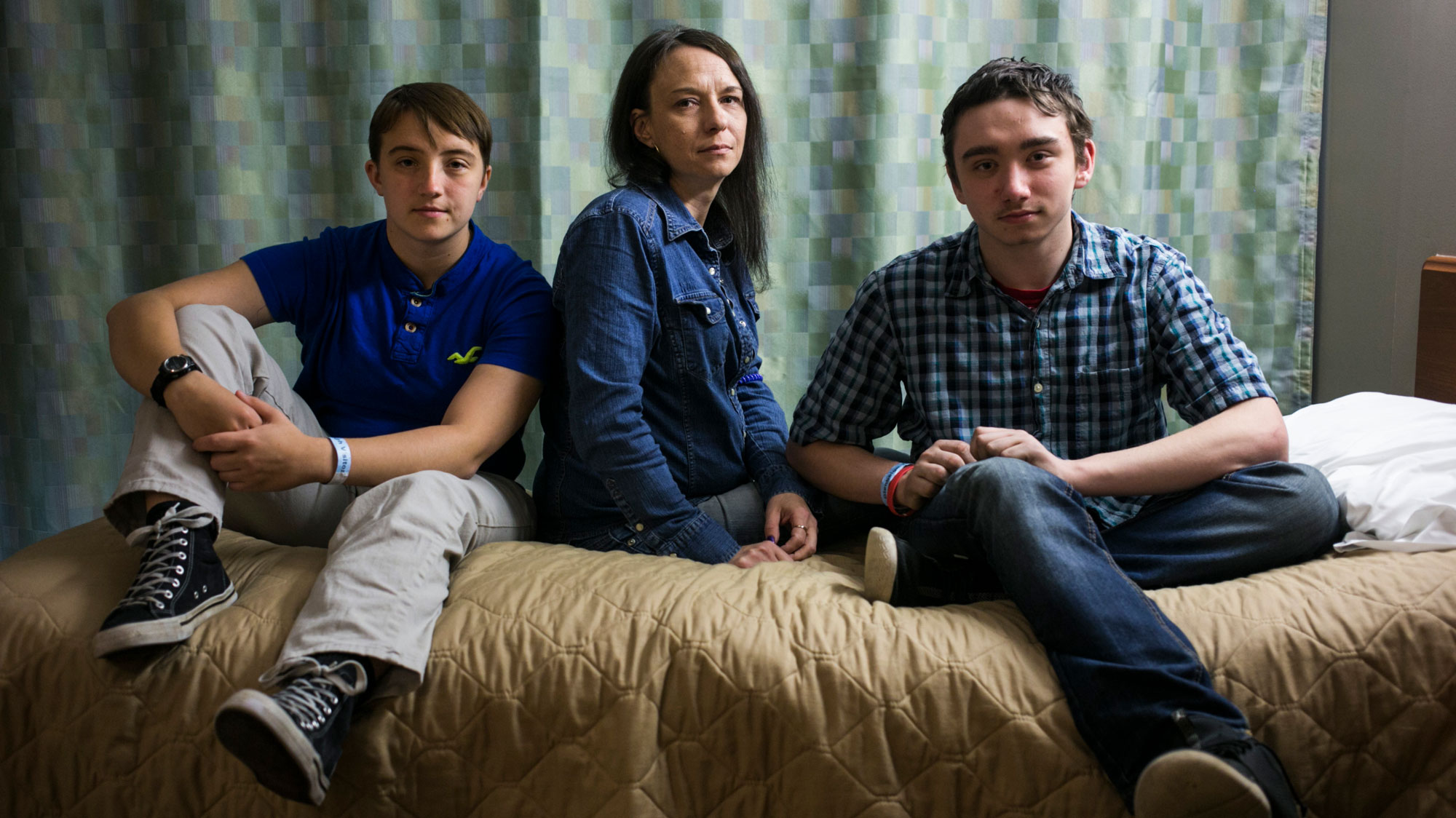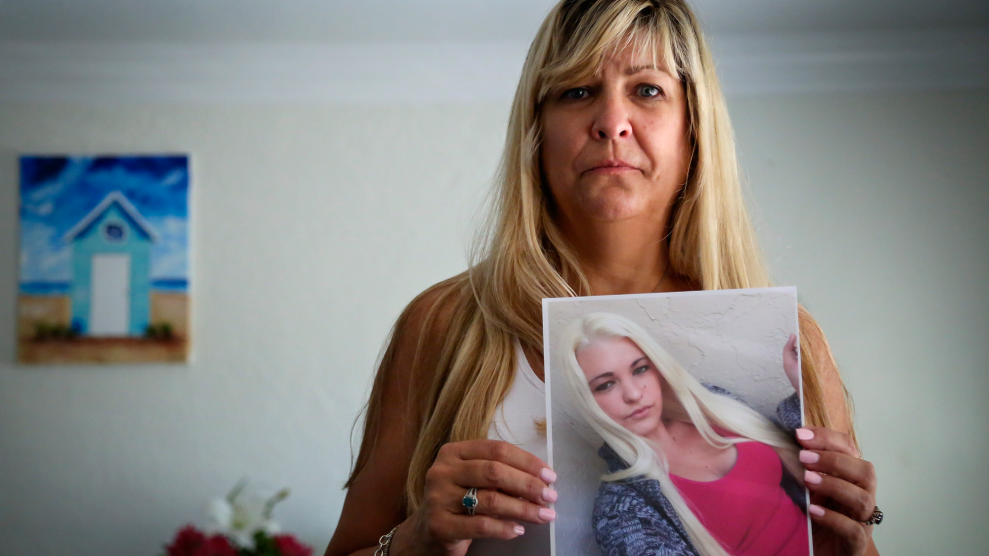Long before the social workers showed up in his living room this March, Matt McLaughlin, a 16-year-old with diabetes, had taken to a wearying evening routine: trying to scrounge up enough spare change for food while his mom, Kelly, went to a neighbor’s house to use heroin. On a good night, the bookish high school junior would walk through his neighborhood in Andover, Ohio, a Rust Belt town surrounded by fields and trailer parks, to pick up frozen pizza from the Family Dollar. On a bad night, he’d play video games to distract himself from his grumbling stomach and dipping blood sugar, and wait for Kelly to return with glazed eyes.
It wasn’t always this way. When Matt was little, Kelly was a Head Start caseworker who patiently taught parents how to manage their autistic children. She loved hosting potlucks with friends and playing Barbie with Matt’s sister, Brianna. There was always music: Tchaikovsky when Kelly was at the piano, or Jimmy Buffett blasting through the speakers while she cooked. “Growing up, we were the house that everyone wanted to come to,” remembered Brianna, now 20. “I loved every minute of it.”
Then Kelly had neck surgery and got addicted to OxyContin. By 2015, she was spending her days napping, disappearing for hours at a time, or going to her neighbor’s house, where she would exchange cash for packets of heroin. She started yelling at the kids, letting the fridge go empty and the house lapse into a den of cigarette butts and dirty dishes. “It’s like her personality did a 180,” Brianna said. “I felt like I lost my mom to this pit that I couldn’t pull her out of.”
On a sunny Tuesday in March, I accompanied Kerri Mongenel and Tim Kiefaber, two caseworkers from Ashtabula County Children Services, as they drove through the cornfields to Kelly’s house, a duplex with peeling paint and blankets covering the windows. A few days earlier, an anonymous tipster had called the police and urged them to check on the family. A rail-thin Kelly, dressed in pajamas, answered the door and invited us in. Then she sat down at the kitchen table, put her head in her hands, and began to weep.
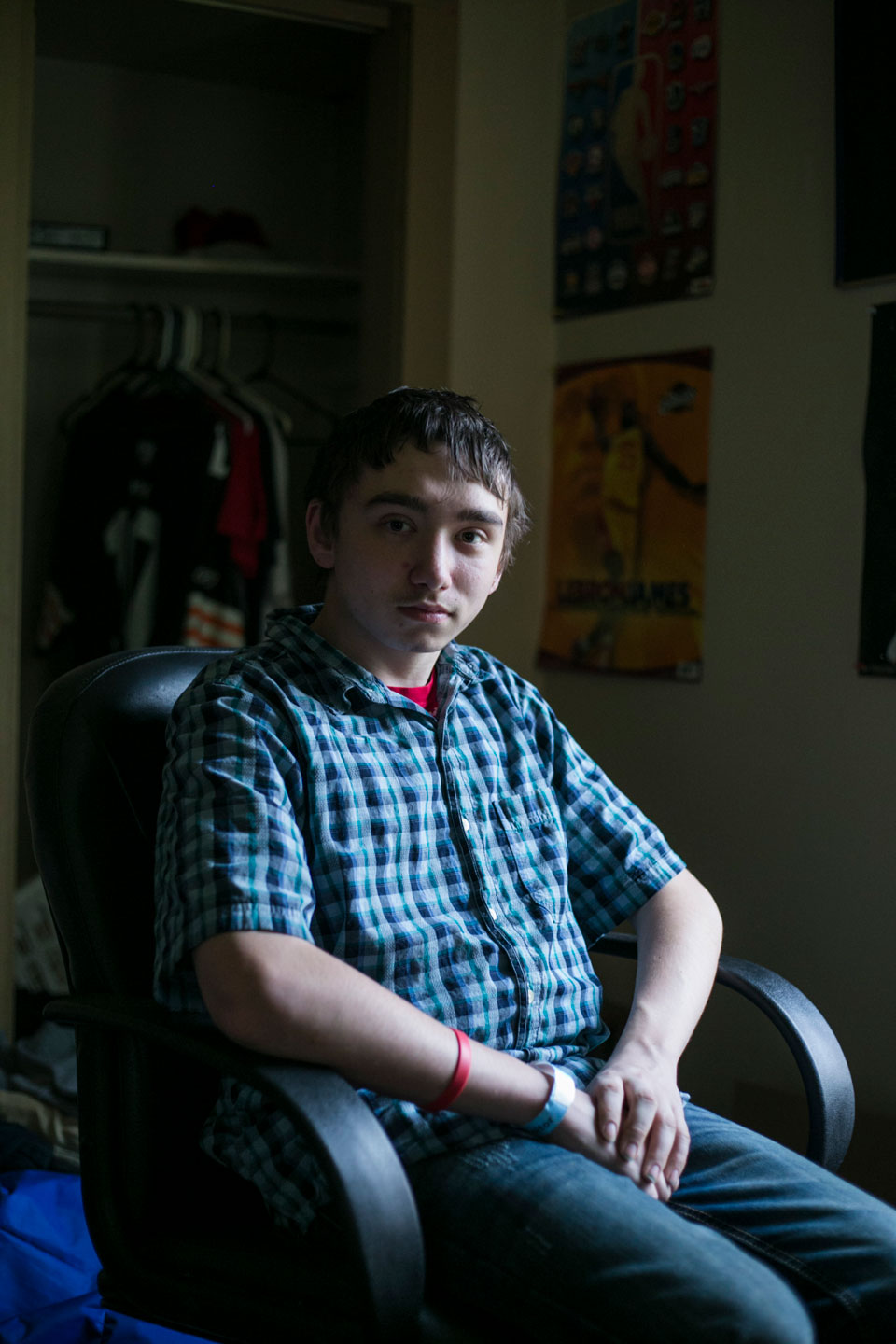
Matt McLaughlin
Brittany Greeson
She’d been to detox several times over the years, she explained, trying to rid herself of what felt like a demon that had taken over her brain. Last year, she managed to stay clean for 63 days, until a friend came over “and laid out a line—and that was all it took.” Now Kelly could rattle off the names of five heroin dealers within a five-mile radius. “I know I need help,” she said through tears. “I just haven’t wanted to admit to Matt that I’d have to go away again.”
By the end of the day, Matt and Kelly had haphazardly packed their bags. Kelly would go to detox yet again. Matt headed to an aunt’s house. He was lucky to have relatives nearby: The spiraling opioid epidemic has disrupted so many families that all the foster homes in Ashtabula County are full.
The scourge of addiction to painkillers, heroin, and fentanyl sweeping the country has produced a flood of bewildered children who, having lost their parents to drug use or overdose, are now living with foster families or relatives. In Ashtabula County, in Ohio’s northeast corner, the number of children in court custody quadrupled from 69 in 2014 to 279 last year. “I can’t remember the last time I removed a kid and it didn’t have to do with drugs,” says Mongenel, a quick-witted redhead. Her clients range from preschoolers who know to call 911 when a parent overdoses to steely teenagers who cook and clean while Mom and Dad spend all day in the bathroom. Often, the kids marvel at how quickly everything changed—how a loving mom could transform, as one teenager put it, into a “zombie.”
The pattern mirrors a national trend: Largely because of the opioid epidemic, there were 30,000 more children in foster care in 2015 than there were in 2012—an 8 percent increase. In 14 states, from New Hampshire to North Dakota, the number of foster kids rose by more than a quarter between 2011 and 2015, according to data amassed by the Annie E. Casey Foundation. In Texas, Florida, Oregon, and elsewhere, kids have been forced to sleep in state buildings because there were no foster homes available, says advocacy group Children’s Rights. Federal child welfare money has been dwindling for years, leaving state and local funding to fill in the gaps. But Ashtabula County is one of the poorest counties in Ohio, and despite a recent boost in funding, the state contributes the lowest share toward children’s services of any state in the country.
More Broken Families, Less Funding
Ohio also has one of the nation’s highest overdose rates. In 2016, at least 4,149 Ohioans died of drug overdose—a 36 percent jump from the year before, according to the Columbus Dispatch. In 2015, 1 in 9 US heroin deaths occurred in Ohio.
It’s hard to overstate just how pervasive the epidemic feels here. Detective Taylor Cleveland, who investigates drug cases in Ashtabula, told me, “I’m dealing with some ruined home two and three times a day.” Cleveland, who coaches youth soccer and recently adopted a 17-year-old player whose mom overdosed, leads a task force that responds to every overdose in the county. Once, he arrived at an overdose scene only to realize that the victim slouched over in the motel room was his cousin, whose young daughter had called 911. “Every OD that happens, I get a text. I’ve gotten two texts while we’ve been talking.” We’d been talking for less than an hour.
Given the scale of the crisis, it’s not hard to understand why, when Donald Trump promised Ohioans on the campaign trail to “spend the money” to confront the opioid crisis and build a wall so drugs would stop flowing in, locals in this historically blue county took notice. In late October, Trump became the first presidential candidate since John F. Kennedy to visit Ashtabula County. He promised to bring back jobs, to open the long-shuttered steel plants, to build the wall. Twelve days later, Ashtabula residents voted for a Republican president for the first time since Ronald Reagan in 1984.
An Epidemic of Overdoses
But since he took office, Trump’s plans to tackle the epidemic head-on have fizzled. Republicans’ recent effort to repeal and replace Obamacare would slash funding for Medicaid, which is the country’s largest payer for addiction services—and which covers nearly half of Ohio’s prescriptions for the opioid addiction medication buprenorphine. The bill would enable insurers in some states to get out of the Obamacare requirement to cover substance abuse treatment. A memo leaked in May revealed Trump’s plans to effectively eliminate the White House’s drug policy office, cutting its budget by 95 percent. (The administration has since backpedaled on the plans, following bipartisan criticism.) Trump’s 2018 budget proposes substantial cuts to the Administration for Children and Families, the Substance Abuse and Mental Health Services Administration, and the Temporary Assistance for Needy Families program.
“I think some people felt as though nothing else is working,” said one Ashtabula resident when I asked why so many in a Medicaid-dependent area would vote for Trump. Now, she says, “I’m really, really scared. You don’t get it until you live in a small town and you see people die every day.”
Like many Rust Belt counties, Ashtabula has seen better days. Locals proudly tell me that the Port of Ashtabula used to be one of the biggest in the world, where barges unloaded iron mined from Minnesota’s Mesabi Range onto trains headed for the steel mills of the Ohio River Valley. Today, once-bustling streets have given way to vacant storefronts and fast-food chains; the surrounding countryside is a patchwork of fields, trailer parks, and junkyards. One in three kids live below the federal poverty line. Less than half of adults have a high school education. The financial downturn accelerated in the ’90s, when manufacturing jobs started disappearing. Meanwhile, newly introduced painkillers like OxyContin and Vicodin were liberally prescribed in communities wrestling with dwindling economic opportunity and rife with workplace injuries common to mines, lumberyards, and factories. As authorities started to tighten the rules on prescribing drugs like OxyContin, the use of heroin, which is chemically nearly identical to opioid painkillers, crept up. But the tipping point, for Ohio and the country, came over the past couple of years, when illicit fentanyl, an opioid up to 100 times more powerful than morphine, started making its way into the heroin supply. Since then, says Dr. Thomas Gilson, the medical examiner for nearby Cuyahoga County, the deaths have been coming “like a tidal wave.”
Mongenel, 33, has lived her whole life in Ashtabula County. Now in her ninth year as a social worker, she has perfected the code-switching that casework requires: She’s gentle with crying toddlers who don’t understand why they can’t see their parents, playful with teenagers over coffee check-ins, and unyielding with doctors who refuse to see the children she calls “my kids” because of insurance complications. When she’s not working, she’s taking care of her own four-year-old, enjoying her vinyl collection, or “mowing” (which is like driving an all-terrain vehicle, except using a lawn mower with the blade up instead). She and Kiefaber typically work as a pair, and they sometimes jam on guitars they keep at the office. Both had tough childhoods: Kiefaber was a foster kid, and Mongenel was raised primarily by her grandmother. “I see myself in so many of these kids,” she says.
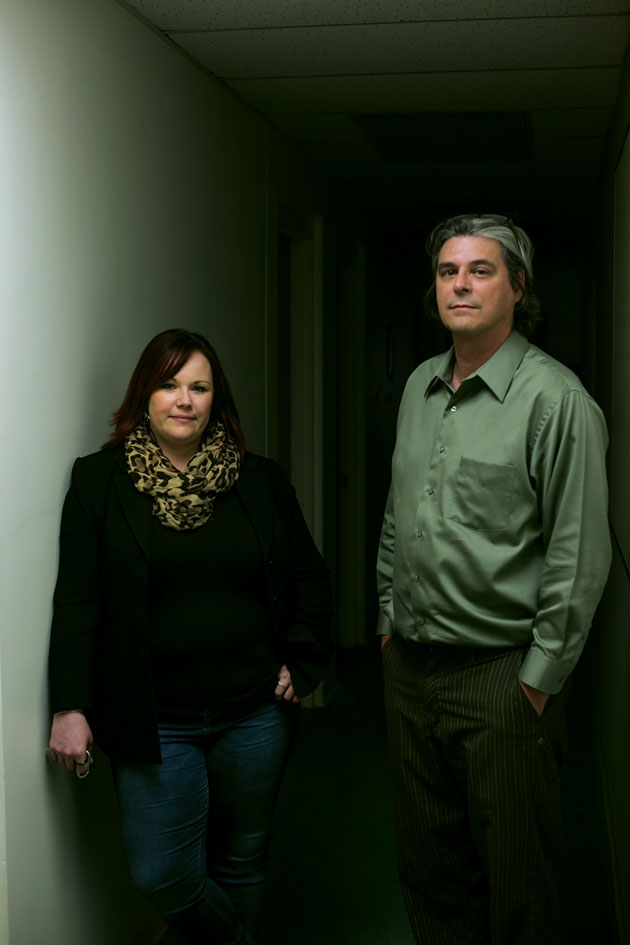
“I can’t remember the last time I removed a kid and it didn’t have to do with drugs,” says Ashtabula County social worker Kerri Mongenel, shown here with her colleague Tim Kiefaber.
Brittany Greeson
About five years ago, Mongenel noticed an uptick in the number of parents using heroin. “I used to get really pissed off at people—like how could you just let me take your kids and then go on a bender?” As she’s learned more about the parasitic way that opioids co-opt the brain, her attitude has softened. Unlike sex abuse or severe physical abuse cases, she said, there is no good guy or bad guy. “You keep thinking, ‘Without the drugs, what would they be like?'”
Gov. John Kasich, a notorious budget hawk, made national news when he pushed Medicaid expansion through Ohio’s conservative Legislature. “When you die and get to the meeting with St. Peter,” he told one lawmaker, “he’s probably not going to ask you much about what you did about keeping government small. But he is going to ask you what you did for the poor.” He made news yet again last week, when he signed a 2018 budget that will, for the first time in years, increase the state’s funding for children’s services. Yet the $30 million boost in funding over two years, which will pay foster parents and provide counseling for the kids, won’t make up for the $55 million increase in child placement costs over the past three years. Other than county pilot programs, “No policy or state investment has focused specifically on the children flooding into county agency custody as a result of the opioid epidemic,” concluded a report by the Public Children Services Association of Ohio this spring. “There has been very little attention to the long-term effects this epidemic will have on children and what Ohio needs to do now to prepare for the onset of behavioral issues, learning disabilities, and developmental delays as children age.”
Meanwhile, federal funding for children’s services decreased by 16 percent between 2004 and 2014. That’s due in part to an arcane law stipulating that the largest pot of federal money for children’s services applies only to kids from below a certain income threshold. In many states, that threshold is about half the poverty level—in Ohio, it’s roughly $14,000 per year for a family of four. But the opioid epidemic has afflicted families of all stripes. “A few years ago, I was constantly just in homes that were clearly in poverty,” says Mongenel. Now she’s struck by her new clients’ well-kept houses: “You pull up to it and it’s like, ‘Really?'”
Tania Burnett, the executive director of Ashtabula County Children Services, told me that more caseworkers are quitting than ever before, unable to reconcile the overwhelming caseload with the paltry salary, which starts at $28,500. “You’re hurrying up, looking at, ‘How can I get this case closed quickly? Because I know another one’s coming.'”
During my visit, Mongenel introduced me to some of her other clients on the condition that I not use their real names. There was Amber, a 16-year-old with long dark hair and big eyes whose mother, Emily, was in and out of rehab for the better part of a year. Mongenel grew close to the mother-daughter pair, both of whom were outgoing and moody and the life of the party. Amber was placed in a group home while Emily cycled in and out of rehab. “There were nights I would go home and cry because she would call me and say, ‘I relapsed again,'” says Mongenel. “And it was like, ‘Okay, let’s try again.’ Try again, try again, try again, over and over.” In December, Mongenel got the phone call that Emily had been found dead, slumped over in a motel bed, and had to break it to an inconsolable Amber that they had run out of chances. Today, Amber wears her mother’s ashes in a tear-shaped necklace and lives in a bustling house with nine other foster kids.
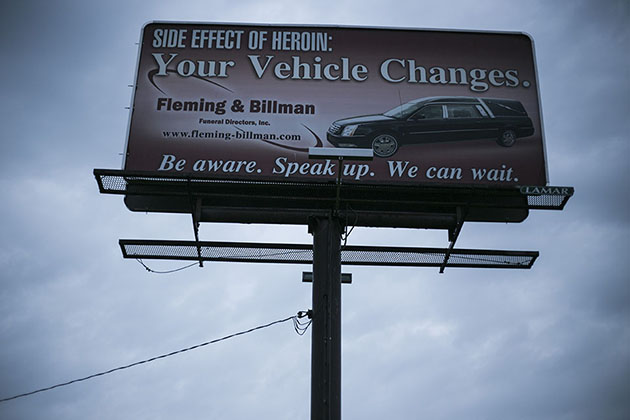
A billboard posted by a local funeral home, Fleming and Billman, in Ashtabula, Ohio
Brittany Greeson
Then there was Jake, a 16-year-old with boy-band looks who holed up for months in a motel over the winter with his two younger siblings, taking courses online and playing video games, while his mom went out to use. “I just want her to go into rehab and get right,” he told me over chicken nuggets at Dairy Queen. “If that could be my birthday present or my Christmas present, that’s what it would be.”
I also met Lisa, a pudgy 10-year-old whom Mongenel and Kiefaber met for the first time in a conference room at her elementary school. Sitting in a chair much larger than she was, Lisa wore leggings and a pearl headband. Her lip quivered. “We’re from children’s services,” said Mongenel gently. “Have you ever heard of that before?” Lisa nodded—they’re the people who go to her friend’s house once a month to make sure everything is okay, she explained.
Mongenel asked questions like, “Do you have enough to eat?” and “Do you like where you’re staying?” and “Do you know what drug use is?” She didn’t say she had just visited Lisa’s house and found Lisa’s father strung out on heroin in the bedroom they share. Lisa’s bed was a pink sleeping bag on a piece of foam surrounded by pill bottles.
Children in Lisa’s situation are subject to incredible psychological stress. There’s the immediate trauma of living with an unstable parent or being taken from family and sometimes from school and friends. But there’s also the long-term impact. Dozens of studies have found that kids who undergo traumatic events early in life are more likely to suffer mental and physical repercussions later on, be it substance abuse, depression, heart disease, or cancer. Among the 10 so-called Adverse Childhood Experiences, or ACEs, are emotional abuse, physical abuse, separation from parents, and parental substance abuse.
“Every time a child gets into a scary or dangerous situation, it activates their stress response,” explains Dr. Nadine Burke Harris, a pediatrician and founder of the Center for Youth Wellness, which focuses on the developmental effects of childhood trauma. “The repeated activation of their stress response is what leads to the biological condition that we in pediatrics are now calling toxic stress.” Looking at the brains of kids of drug users, Burke Harris says, one would expect to see the signs associated with other types of trauma: an enlarged amygdala, the brain’s fear center; decreased functioning of the nucleus accumbens, the brain’s pleasure and rewards center; and less activity in the prefrontal cortex, which oversees a child’s ability to control impulses and pay attention.

Read our interview with Dr. Nadine Burke Harris about the effect of the opioid epidemic on kids’ brains.
Mongenel and Kiefaber are familiar with the latest research on ACEs. They know that a child with four or more ACEs is twice as likely as other kids to develop cancer and ten times more likely to inject drugs themselves. When they encounter someone like Lisa, they are torn between mitigating one ACE, exposure to parental substance abuse, and catalyzing another: separating a child from her parents. Which is what makes these conversations so heart-wrenching.
When Mongenel asked Lisa if she knew what drug abuse was, Lisa told us she’d heard of marijuana and knew it was bad. Her dad takes medication, she said, but that’s because his back hurts. When Mongenel asked if she would rather live somewhere else, Lisa’s brow furrowed in confusion and her hands began to shake. “There’s no place I’d rather be,” she pleaded. “I just want to be with my family.”
For Mongenel, one of the most difficult things about managing opioid cases is how unpredictable they can be—she never knows how a client’s drug-addicted parent will do after detox. Some thrive and are quickly reunited with their families. Others can’t pull themselves out of the black hole of addiction.
A few weeks after leaving Ohio, I asked about Kelly—the mother of Matt, the diabetic teenager. Kiefaber told me that he was optimistic: Kelly had sailed through detox and been sober for nearly a month.
I called Kelly, and she really did sound great, clear and full of confidence. “When I was using, I would sleep half the day away” and wake up feeling sick from heroin cravings, she said. “Now I’ve been setting my alarm. I wake up early, enjoy my coffee, open the blinds, and let in the sunshine.” On her walks to town, she said, she crossed the street and looked straight ahead to avoid catching a glimpse of her dealer’s house, an ever-present temptation. Brianna had moved back in to help her mom, but come fall she’d attend college—training to be a social worker. “I’m going to be her first case,” joked Kelly.
Matt, still in his junior year of high school, was living with his aunt, but he’d go over to his mom’s on Saturdays and the three of them would listen to music and make dinner. “I’m nervous, but I think she’s got it this time,” Matt told me. “She’s acting a lot more like herself.”
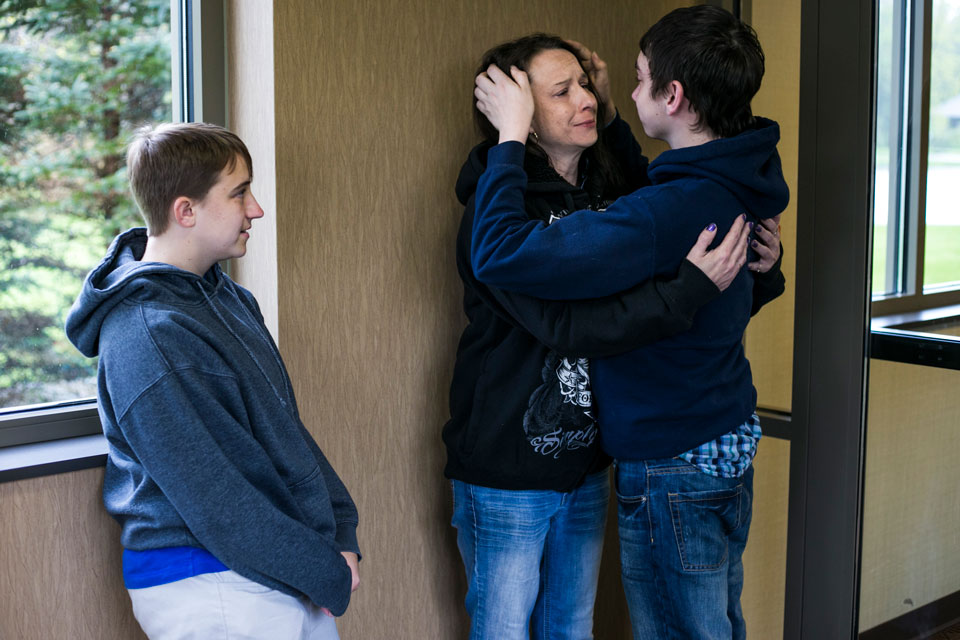
Hearing all this, I was reminded of other recovering moms I’d met in Ashtabula—women who felt like they’d managed, after years of relapses, to pull themselves out of a terrible dream and today find themselves going above and beyond to show their kids they can be trusted again. “I guess I try so hard to make up for that time,” said one mom, a soft-spoken former nurse’s aid named Joanne Eager who used to turn tricks for drug money after dropping her kindergartner off at school. These days, she prepares elaborate blueberry pancake breakfasts for her kids and makes sure dinner is in the slow cooker before she heads to work.
I wrote a happy ending to this piece and filed it to my editor.
A few weeks later, midway through a revision of my story, I had a few follow-up questions for Brianna. When I told her why I was calling, there was a long, awkward silence. Finally, she said, “I’m not sure if I’m supposed to say this, but my mom relapsed last week.” She’d gone to pay off her dealer, and the dealer had laid out a line. Kelly didn’t say no. When Kelly told her kids, Brianna fumed. Matt said nothing. Kelly checked herself into inpatient treatment an hour away; Brianna and Matt planned to visit if they could get a ride.
Days later, I got a call from an unknown number—the detox center, it turns out. Kelly sounded like the same person I’d talked to a few weeks before, only very, very tired. We chatted for a while about what her days looked like—the hours of therapy and 12-step sessions—and then I blurted out the question that had been plaguing me. How did it go telling her kids she had relapsed?
“I’ve hurt both of my kids very much,” she said. “They have every right to be pissed off and frustrated and everything else. I’m just lucky that they haven’t written me off. My kids have been my life.”
And what about you? I asked. How are you doing?
She paused and took a deep breath. “Sometimes, Julia, I think, ‘What the hell is wrong with me? Why do I keep letting the demon take over?'”
As Mongenel would say: Try again, try again, try again.
